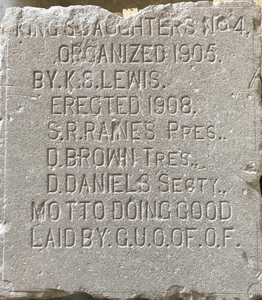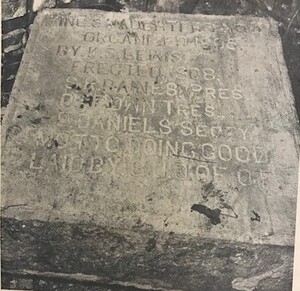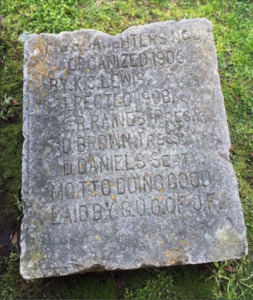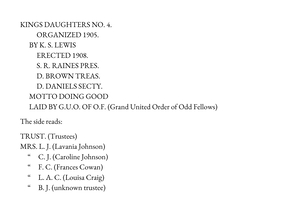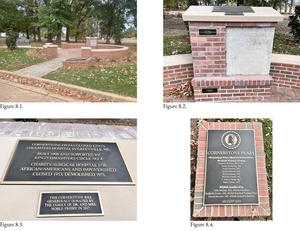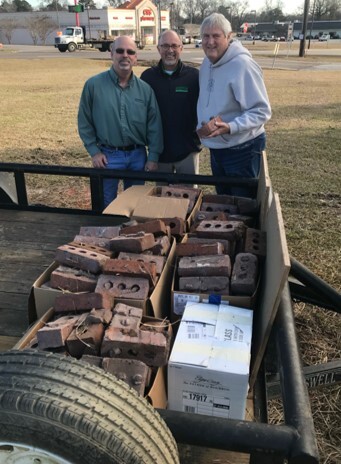The cornerstone of the Colored King’s Daughter’s Hospital (CKDH) in Greenville has lived a life in relative obscurity – until now. It was put into place in 1908 with somewhat of a time capsule embedded in its top; it contained a Bible, a newspaper, and a book. The Greenville City Council and the Washington County Board of Supervisors authorized funding of the construction of a facility to be used as a hospital for African-American patients. This support came about due to the efforts of the philanthropic and charitable-minded women of Greenville’s Colored King’s Daughters, also known as King’s Daughters Circle No. 4. (FIGURE 1) The cornerstone quietly witnessed the happenings of that hospital and was even submerged for a while during the 1927 Flood. When the hospital closed in 1953 and was subsequently converted into apartments, the cornerstone remained in place. In 1971, the building was demolished to erect a new apartment building. The cornerstone was left lying on the ground, and the contents of the time capsule had severely deteriorated. This instance was the first time it had been disturbed in 63 years, and then, for only a short distance. (FIGURE 2) The hospital was reportedly located towards the back of the property, and the cornerstone appears to have been on a front-facing brick pillar. The new apartment building was located more towards the front of the property facing Alexander Street. It may be that the cornerstone just lay close to where it fell for another 46 years. The owner of the property, Dr. Noble R. Frisby, confirmed the presence and location of the cornerstone in a 1977 oral history interview. However, generally, the cornerstone and its story were usually mentioned in passing, if at all, and any details were vague and non-specific.
In 2016, the Commemorative Committee of the Mississippi State Medical Association (MSMA) was formed with the goal to organize and fund a commemorative program to celebrate the 150th anniversary of the MSMA House of Delegates at Annual Session 2018. Executive Director Charmaine Kanosky organized the committee. I had the distinct honor to chair this extraordinary group, the core of which consisted of Drs. Ralph Didlake, Randy Easterling, Hugh Gamble, Luke Lampton, Marty Tucker, and Helen Turner, as well as Karen Evers and Charmain from MSMA. The group quickly coalesced over a love of Mississippi’s medical history. For two years, we met regularly for our work. A fund-raising effort was initiated, and a program planned and developed. We also discussed other projects to undertake. One of the ideas that came up in 2017 was to find and preserve relics of the state’s medical history. It seemed worthwhile to chase down the reality of the CKDH cornerstone in Greenville.
The search was relatively simple. With the help of long-time Greenvillians and good friends John Black and Steve Osso, the cornerstone was found where it was rumored to be – behind the Frisby Apartments, lying in the dirt next to an air-conditioning unit. The apartments now occupy the site where the CKDH once stood. My initial impression upon seeing it was that it appeared to be reasonably well-preserved and looked really heavy. (FIGURE 3) For some reason, a sudden sense of urgency arose as if the cornerstone was living on borrowed time.
The legwork then began. I presented the situation to the Commemorative Committee, and all agreed that it should be rescued and preserved. As we had no specific plans for it nor the means to develop any, the best goal seemed to be to acquire ownership by MSMA and safely store it for a future project. I contacted Dorothy J. Smith Nelson who owned and managed the Frisby Apartments and is a member of the Frisby family. Through their legal representative, the family of Dr. and Mrs. Noble R. Frisby graciously agreed to donate the cornerstone to MSMA.
Next, the cornerstone had to be moved from behind the apartment building to a place of safe storage. I contacted Delta Regional Medical Center (DRMC, now Delta Health System), and they kindly agreed to donate their assistance in this effort. Paul Dillon, Director of Plant Operations, led a team that was able to safely move the cornerstone using a combination of rollers and a forklift. (FIGURE 4) After being loaded onto a trailer, it was taken to DRMC’s warehouse, pressure-washed, and stored on a pallet. Hugh Gamble went over and confirmed its authenticity.
There it rested. The 2018 Commemorative Program was a success in all regards. Fund-raising efforts had generated approximately $140,000. The Commemorative Committee had performed above expectations. In addition to the program, a beautiful book, Images in Mississippi Medicine, had been produced by Luke Lampton and Karen Evers as a Commemorative Committee project. When the group met afterwards to recap, all agreed that the entire two-year experience had been rewarding and very worthwhile. In fact, so much so that the consensus was that we should continue this important effort. We reformed as the MSMA Medical History Group (MHG). New Executive Director Claude Brunson came on board, and Vonda Reeves volunteered to join as a new member. New MHG projects are always being discussed and evaluated, pending projects are completed, and ongoing projects continue to move ahead. Some of these are: the Oral History Project under the direction of Helen Turner; the Gavel Project in which craftsman Irby Stewart of Madison created a new MSMA Gavel of historic woods obtained from the Mississippi State Hospital at Whitfield (circa 1926), Mississippi State Tuberculosis Sanatorium near Magee (circa 1921), Afro-American Sons and Daughters Hospital in Yazoo City (circa 1935), and the Arthur C. Guyton, M.D., Department of Physiology Workshop at UMMC (circa 1985); and, with the assistance of MSMA’s Becky Wells, the establishment of the MSMA MHG History of Medicine Lectureship given annually at the Annual Session of the House of Delegates. Irby Stewart also crafted protective display cases with provenances for the two previous MSMA Gavels and the original materials used for the first Covid vaccination in Mississippi. I remained at the helm for another year, and then Ralph Didlake took over.
Following the relocation of the cornerstone to the DRMC warehouse, I approached organizations in Greenville and Jackson to gauge interest in a joint project with MSMA to utilize the cornerstone for its historical and educational value while preserving the relic of medical history. Interest just wasn’t there. That opened opportunity for the MHG. We took another look at the cornerstone situation in 2020 to discuss various options. Some of us were just hoping to get it safely to Jackson and maybe put it outside the MSMA offices. However, Claude Brunson had the brilliant idea and the vision; thus, the Cornerstone Plaza Project was born. The MHG had always aimed high, as Randy Easterling had done with the budget goal of the 2018 Commemorative Program. That goal was met and exceeded. Now, Claude was doing the same thing and aiming high for the physicians of Mississippi – a Commemorative Plaza displaying the cornerstone and other Mississippi medical history relics. We had the idea to obtain and incorporate bricks from still-remaining ruins of old Mississippi hospitals that had served African-American patients and the impoverished, as well as any plaques or nameplates from them that we could find.
The first step was to get the cornerstone to Jackson. Hugh Gamble worked with Delta Health and, once again, they donated the resources and manpower to accomplish the move to the MSMA warehouse seamlessly. (FIGURE 5) Landscape architects were engaged, and plans began to be developed, as Ivory Bogan was MSMA’s liaison with them. Fund-raising efforts were organized, and a fund-raising campaign initiated. After obtaining permission from the hospital owners, Marty Tucker, myself, and my grandson were able to get 250 bricks from the ruins of the Afro-American Sons and Daughters Hospital in Yazoo City. (FIGURE 6) This endeavor was not exactly seamless, but smooth-talking Marty deftly handled a brief encounter with the local police. The bricks arrived safely to the MSMA warehouse. Randy was able to do the same thing with 250 bricks from the remnants of the Matty Hersee Hospital in Meridian more smoothly, and without encountering local law enforcement. (FIGURE 7)
During the research for the article on the history of the CKDH, much of the mystery of the information on the cornerstone was uncovered. The front of the cornerstone reads (expansions in italics, based on best available information):
The fund-raising campaign was successful, generating just over $150,000 for this project. Groundbreaking occurred on August 18, and the Cornerstone Plaza was dedicated on November 30. The Plaza will be a tribute to the facilities that cared for African-American patients and the impoverished in the past. (FIGURE 8)
An artifact without context is somewhat useless. This article and the companion history of the CKDH provide the necessary context. The CKDH cornerstone is a cultural artifact of medical history, a cultural resource of the state, and a cornerstone of Mississippi’s medical history.

